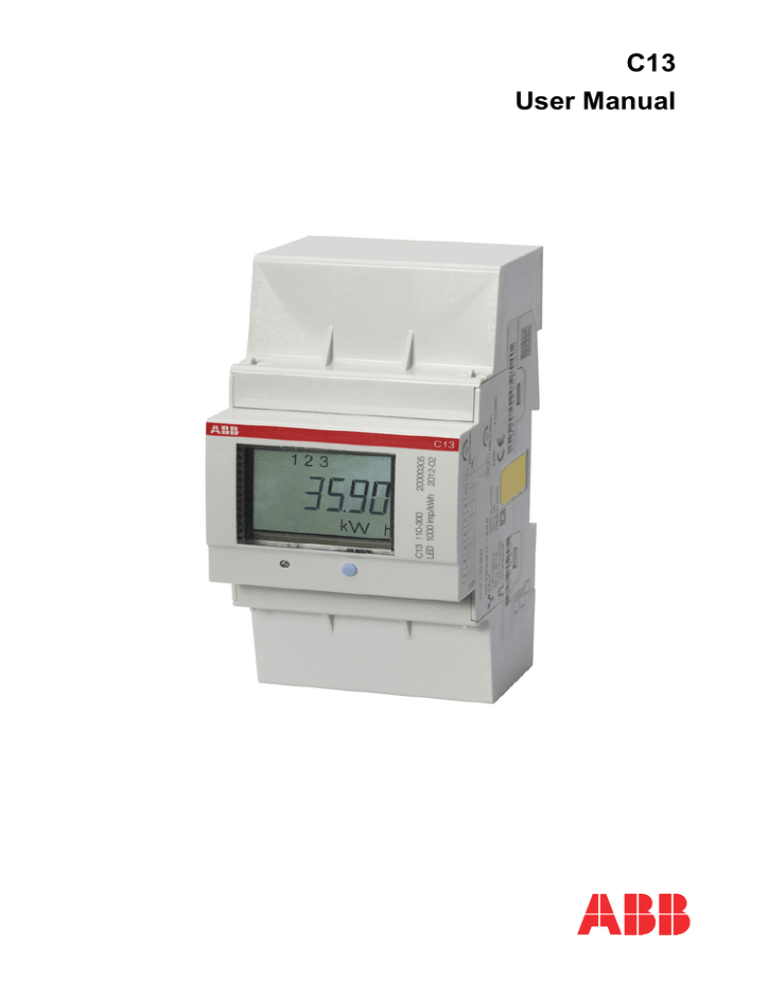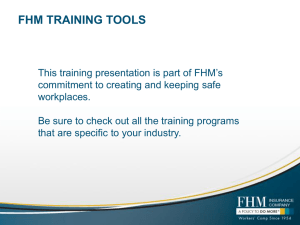
C13
User Manual
C13
User Manual
Document ID: 2CMC486004M0201
Revision: A
2013-06-19
Disclaimer
The information in this document is subject to change without notice and should
not be construed as a commitment by ABB AB. ABB AB assumes no responsibility for any errors that may appear in this document.
In no event shall ABB AB be liable for direct, indirect, special, incidental or consequential damages of any nature or kind arising from the use of this document,
nor shall ABB AB be liable for incidental or consequential damages arising from
use of any software or hardware described in this document.
Copyrights
This document and parts thereof must not be reproduced or copied without written
permission from ABB AB, and the contents thereof must not be imparted to a
third party nor used for any unauthorized purpose.
The software or hardware described in this document is furnished under a license
and may be used, copied, or disclosed only in accordance with the terms of such
license.
© Copyright 2013 ABB AB. All rights reserved.
Trademarks
ABB AB is a registered trademark of the ABB Group. All other brand or product
names mentioned in this document may be trademarks or registered trademarks
of their respective holders.
Contact
ABB AB
P.O. BOX 1005
SE-611 29 NYKÖPING
SWEDEN
Tel: +46 155 295000
Fax: +46 155 288110
1 About this Manual ........................................................................................ 3
1.1 Conventions Used in this Document .............................................................................. 4
2 Product Overview ......................................................................................... 5
2.1 Meter Parts .................................................................................................................... 6
2.2 Meter Type ..................................................................................................................... 7
3 Installation .................................................................................................... 9
3.1 Mounting the Meter ...................................................................................................... 10
3.2 Environmental Considerations ..................................................................................... 11
3.3 Installing the Meter ...................................................................................................... 12
3.3.1 Wiring Diagrams ................................................................................................ 13
3.3.1.1 Outputs .................................................................................................. 13
4 User Interface ............................................................................................. 15
4.1 Display and buttons ..................................................................................................... 16
4.2 Menu Structure ............................................................................................................ 17
5 Meter Settings ............................................................................................ 21
5.1 Setting the Output ........................................................................................................ 22
5.2 Setting the Alarm ......................................................................................................... 24
6 Technical Description ................................................................................ 27
6.1
6.2
6.3
6.4
Energy Values ............................................................................................................. 28
Instrumentation ............................................................................................................ 29
Outputs ........................................................................................................................ 30
Alarm ........................................................................................................................... 31
7 Technical data ............................................................................................ 33
7.1 Technical Specifications .............................................................................................. 34
7.2 Physical Dimensions .................................................................................................... 36
8 Troubleshooting ......................................................................................... 37
8.1 Error Codes and Warnings .......................................................................................... 38
9 Service & Maintenance .............................................................................. 39
9.1 Service and Maintenance ............................................................................................ 40
2CMC486004M0201
Revision: A
1
C13
User Manual
C13
User Manual
2
2CMC486004M0201
Revision: A
About this Manual
Chapter 1: About this Manual
Overview
This chapter describes the conventions used in this manual. It also contains explanations and definitions of terms and definitions that are used in the document.
In this chapter
The following topics are covered in this chapter:
1.1 Conventions Used in this Document ..................................................... 4
2CMC486004M0201
Revision: A
3
C13
User Manual
About this Manual
1.1 Conventions Used in this Document
Symbols
This document contains warning, caution, note and tip icons that point out safety
related conditions and other important or useful information.
Symbol
Description
The electrical warning icon indicates the presence of a hazard which
could result in electrical shock.
The caution icon indicates important information or a warning related
to the concept discussed in the text. It might indicate the presence of a
hazard which could result in corruption of software or damage to equipment or property.
The note icon alerts the reader to important facts and conditions.
The tip icon gives the reader useful information related to the concept
discussed in the text.
C13
User Manual
4
2CMC486004M0201
Revision: A
Product Overview
Chapter 2: Product Overview
Overview
This chapter describes the parts of the meter. It also contains information about
the meter type.
In this chapter
The following topics are covered in this chapter:
2.1 Meter Parts ............................................................................................ 6
2.2 Meter Type ............................................................................................ 7
2CMC486004M0201
Revision: A
5
C13
User Manual
Product Overview
2.1 Meter Parts
Illustration
The parts of the meter are shown in the illustration below:
1
1
1
8
2
2
6
7
5
8
4
Parts description
The following table describes the parts of the meter:
Item
C13
User Manual
3
Description
Comments
1
Terminal for output connections
2
Sealing points
3
Push button
For programming and reading metering
data
4
LED
Flashes in proportion to the energy
measured
5
Display
LCD for meter reading
6
Sealing label
7
Product data
8
Terminal block
6
2CMC486004M0201
Revision: A
Product Overview
2.2 Meter Type
C13 meter
The C13 is a compact meter for 3-phase metering. The meter is direct connected
for currents up to max. 40 A.
Product label
The meter type information that is reflected on the product label is shown in the
example picture below:
Label information
The information on the type label is explained in the table below:
Item
1
2CMC486004M0201
Revision: A
Description
Type designation
2
LED pulse frequency
3
Serial number
4
Manufacturing date (year and week)
5
Wiring diagram
6
Bar code with serial number
7
Type designation
8
Energy import
9
Accuracy (active energy)
10
Nominal voltage
11
3-element metering
7
C13
User Manual
Product Overview
Item
C13
User Manual
Description
12
Frequency
13
LED pulse frequency
14
Pulse frequency
15
Protection class II
16
Operating temperature range
17
Rated current
18
ABB ID
8
2CMC486004M0201
Revision: A
Installation
Chapter 3: Installation
Overview
This chapter describes how to mount the C13 meter and how to connect it to an
electricity network.
In this chapter
3.1 Mounting the Meter .............................................................................. 10
3.2 Environmental Considerations ............................................................. 11
3.3 Installing the Meter .............................................................................. 12
3.3.1 Wiring Diagrams ........................................................................ 13
2CMC486004M0201
Revision: A
9
C13
User Manual
Installation
3.1 Mounting the Meter
General
This section describes different ways to mount the C13 meter. For some methods
of mounting, additional accessories are needed. For further information about accessories, refer to Main Catalog (2CMC481003C0201).
DIN-rail mounted
The C13 meters are intended to be mounted on a standard (DIN 50022) DIN-rail.
If this method of mounting is used no extra accessories are needed and the meter
is fastened on the rail by snapping the DIN-rail lock onto the rail.
Wall mounted
The recommended way to mount the meter on a wall is to mount a separate DINrail on the wall and then mount the meter on the rail.
Standard DIN-rail
The following picture shows a standard DIN-rail.
C13
User Manual
10
2CMC486004M0201
Revision: A
Installation
3.2 Environmental Considerations
Ingress protection
To comply with the protection requirements the product must be mounted in protection class IP 51 enclosures, or better, according to IEC60259.
Mechanical environment
In accordance with the Measuring Directive (2004/22/EC), the product complies
with M1, which means that it can be operated in “...locations with vibration and
shocks of low significance, e.g. for instruments fastened to light suporting structures subject to negligible vibrations and shocks transmitted from local blasting
or pile-driving activities, slamming doors, etc.”
Electromagnetic environment
In accordance with the Measuring Directive (2004/22/EC), the product complies
with E2, which means that it can be operated “...in locations with electro magnetic
disturbances corresponding to those likely to be found in other industrial buildings.”
Climatic environment
In order to work properly the product should not be operated outside the specified
temperature range of -40°C – +70°C.
In order to work properly the product should not exposed to humidity exceeding
the specified 75% yearly average, 95% on 30 days/year.
2CMC486004M0201
Revision: A
11
C13
User Manual
Installation
3.3 Installing the Meter
E
Warning – Electrical equipment should only be installed, accessed, serviced and
maintained by qualified electrical personnel.
E
Warning – For safety reasons it is recommended that the equipment is installed in a
way that makes it impossible to reach or touch the terminal blocks by accident.
E
Warning – The meters must always be protected by fuses on the incoming side.
Installation
requirements
Working with high voltage is potentially lethal. Persons subjected to high voltage may
suffer cardiac arrest, burn injuries, or other severe injuries. To avoid such injuries,
make sure to disconnect the power supply before you start the installation.
The best way to make a safe installation is to install the unit in an enclosure. Further,
access to the equipment should be limited through use of lock and key, controlled by
qualified electrical personnel.
In order to allow for maintenance of transformer rated meters, it is recommended that
there should be a short circuiting device installed near the meter.
To comply with the protection requirements the meter must be mounted in protection class IP 51 enclosures, or better, according to IEC 60259.
Meters with wireless communication should not be installed closer than 20 cm
from people.
Install the meter
Follow the steps in the table below to install the meter:
Verify the
installation
C13
User Manual
Step
Action
1
Switch off the mains power.
2
Place the meter on the DIN-rail and make sure it snaps onto it.
3
Strip the cable insulation to the length that is indicated on the meter.
4
Connect the cables according to the wiring diagram that is printed on the meter and tighten the screws (0.8 Nm).
5
Install the circuit protection (max 40 A).
6
Connect the output to an external power supply (max 5–40 V). See the wiring
diagram printed on the meter.
7
Turn on the mains power.
The C13 meter has a red LED next to the push button on the front of the meter
that flashes proportionally to the active energy. The LED has a fixed pulse frequency of 1000 imp/kWh and can be used to test and verify the installation. If the
LED flashes when the mains power is turned on, the installation was successful.
12
2CMC486004M0201
Revision: A
Installation
3.3.1
Wiring Diagrams
4-wire connection
The following diagram shows a 4-wire connection of a direct connected 3-phase
meter:
1
3.3.1.1
3
4
6
7
9 10 12
Outputs
Fixed, 1 output
2CMC486004M0201
Revision: A
13
C13
User Manual
Installation
C13
User Manual
14
2CMC486004M0201
Revision: A
User Interface
Chapter 4: User Interface
Overview
This chapter gives an overview of the display and of the functions of the button
on the meter.
In this chapter
The following topics are covered in this chapter:
4.1 Display and buttons ............................................................................. 16
4.2 Menu Structure .................................................................................... 17
2CMC486004M0201
Revision: A
15
C13
User Manual
User Interface
4.1 Display and buttons
Display
The display consists of icons, digits and letters. The measured value/menu options
are displayed with large letters. The measured unit is displayed on the bottomright side of the display, and the status icons are displayed at the upper part of the
display, see figure below.
123
k Arh
Status Icons
The status icons are shown in the table below.
Icon
Indication
Comment
Active error
When a error has been detected,
the icon will be lit on the display.
When no error has been detected,
the icon will be turned off.
Metering in progress.
When a load is connected to the
meter, the icon will flash to indicate
metering. When no load is connected, the icon will be turned off.
!
Button
C13
User Manual
The meter has one push button which is located below the display. A short press
on the button (less than 1 sec) will step through the menu/submenu. A long press
(more than 1 sec) followed by a release of the button will open the set menu or
select an item in the menu.
16
2CMC486004M0201
Revision: A
User Interface
4.2 Menu Structure
Overview
This section will give an introduction to the menu structure.
Menu structure
The menu structure of the meter can be viewed in the following figure
View menu
Set menu
– Active energy
Select function
Set alarm
Alarm power
– Active energy
max resolution–
Alarm level
on
Alarm voltage, L1
Output
Alarm voltage, L2
– Exit
– Active power,
Alarm on
delay
Alarm voltage, L3
total
– Active power, L1
Alarm current, L1
– Active power, L2
– Active power, L3
– Voltage, L1
Alarm current, L2
Alarm level
off
Alarm current, L3
Alarm off
delay
Alarm power factor
– Voltage, L2
– Voltage, L3
– Current, L1
Save
Pulse output
Out on
– Current, L2
Exit
– Current, L2
Out off
– Power factor
– Output state
Exit
– Version
– CrC
– Error
Navigation
To navigate in the menu, use the short press to navigate between the different
menu items, and the long press to select a menu item. When performing settings,
the short press is used to change the value of a specific setting, and the long press
is used to toggle between different digits.
View menu
In the view menu, the following choices can be made.
2CMC486004M0201
Revision: A
Choice in menu
Output on
display
No. of
digits
No. of
Unit
decimals
Min.
value
Max. value
Active energy
<numerical
value>
kWh
7
0
0
9999999
17
kWh
C13
User Manual
User Interface
Choice in menu
Output on
display
No. of
digits
No. of
Unit
decimals
Min.
value
Max. value
Active energy max <numerical
resolution
value>
Wh
6
3
Wh
0
999.999
Active power Total <numerical
value>
W
5
0
W
0
99999
Active power
Phase 1
<numerical
value>
W
5
0
W
0
99999
Active power
Phase 2
<numerical
value>
W
5
0
W
0
99999
Active power
Phase 3
<numerical
value>
W
5
0
W
0
99999
Voltage Phase 1
<numerical
value>
V
3
0
V
0
999
Voltage Phase 2
<numerical
value>
V
3
0
V
0
999
Voltage Phase 3
<numerical
value>
V
3
0
V
0
999
Current Phase 1
<numerical
value>
A
3
1
A
0
99.9
Current Phase 2
<numerical
value>
A
3
1
A
0
99.9
Current Phase 3
<numerical
value>
A
3
1
A
0
99.9
Power factor
<numerical
value>
4
3
N/A
0
1
- Alarm on, or
N/A
N/A
N/A
N/A
N/A
- Alarm off, or
N/A
N/A
N/A
N/A
N/A
- Output on, or
N/A
N/A
N/A
N/A
N/A
- Output off, or
N/A
N/A
N/A
N/A
N/A
- Pulse out
N/A
N/A
N/A
N/A
N/A
Firmware version
Part 1
N/A
3
N/A
N/A
1
255
Firmware version
Part 2
N/A
3
N/A
N/A
0
255
Firmware version
Part 3
N/A
3
N/A
N/A
0
255
Output state
C13
User Manual
18
2CMC486004M0201
Revision: A
User Interface
Set menu
Set alarm menu
2CMC486004M0201
Revision: A
Choice in menu
Output on
display
No. of
digits
No. of
Unit
decimals
Min.
value
Max. value
CRC Part 1
N/A
4
N/A
N/A
0000
FFFF
CRC Part 2
N/A
4
N/A
N/A
0000
FFFF
Error
Er <numerical 4
value>
N/A
N/A
N/A
N/A
The set menu is used to set different options in the meter. The set menu is reached
by using the long press when located in the view menu. The following choices are
available in the set menu, see table below.
Choice in menu
Output on display
Output
Exit
When choosing Exit, the menu will return to the view menu. When choosing Output, the following choices will be available.
Choice in menu
Output on display Explanation
Alarm power
VV
By choosing this option, the
alarm will be set with regards to
the measured power.
Alarm voltage
V
By choosing this option, the
alarm will be set with regards to
the measured voltage on
Phase 1.
Alarm voltage
V
By choosing this option, the
alarm will be set with regards to
the measured voltage on
Phase 2.
Alarm voltage
V
By choosing this option, the
alarm will be set with regards to
the measured voltage on
Phase 3.
Alarm current
A
By choosing this option, the
alarm will be set with regards to
the measured current on Phase
1.
Alarm current
A
By choosing this option, the
alarm will be set with regards to
the measured current on Phase
2.
Alarm current
A
By choosing this option, the
alarm will be set with regards to
the measured current on Phase
3.
19
C13
User Manual
User Interface
Choice in menu
Output on display Explanation
Alarm power factor
By choosing this option, the
alarm will be set regarding to
the measured power factor.
Pulse output
By choosing this option, the
pulse output function will be activated.
Out on
By choosing this option, the
output will be set to static on.
Out off
By choosing this option, the
output will be set to static off.
Exit
Go back to the set menu.
When either Alarm power, Alarm voltage, Alarm current or Alarm factor has
been chosen, the following choices will be available.
C13
User Manual
Choice
Output on display
Unit
Explanation
Alarm level on
W/V/A/-
When the measured value
passes the set value, the
alarm will be triggered.
Alarm on delay
seconds
When the measured value
passes the set value and
remains for the set time,
the alarm will be triggered.
Alarm level off
W/V/A/-
Alarm off delay
seconds
When the measured value
passes the set value, the
alarm will be cleared.
When the measured value
passes the set value and
remains for the set time,
the alarm will be cleared.
Save
N/A
This option saves the
alarm settings.
Exit
N/A
Go back to the set menu
without saving. Use this
option to view the current
alarm settings.
20
2CMC486004M0201
Revision: A
Meter Settings
Chapter 5: Meter Settings
Overview
This chapter describes how to configure the functions of the meter, including
alarm settings.
In this chapter
The following topics are covered in this chapter:
5.1 Setting the Output ................................................................................ 22
5.2 Setting the Alarm ................................................................................. 24
2CMC486004M0201
Revision: A
21
C13
User Manual
Meter Settings
5.1 Setting the Output
About the output
The C13 meter has one output which can be used for three different purposes.
When one of the three options has been chosen for the output, the remaining two
options are automatically disabled.
• Alarm monitoring
The output is used for monitoring if an alarm has been triggered or not.
• Static level
The output is set as static, either as static on or static off.
• Pulse output
The output is set as a pulse output.
Output state
The Output state in the main menu indicates what function is activated. See table
below for the different functions that can be activated
Set output to
pulse output
C13
User Manual
Activated function
Output on display
Comment
Alarm on
The alarm is set and has been triggered.The pulse output exit is deactivated.
Alarm off
The alarm is set but has not been triggered. The pulse output exit is deactivated.
Output on
There is always a continous signal on the
output.
Output off
The output is closed for all traffic, both inbound and outbound.
Pulse out
The output is activated with a frequency
based on measured energy. The alarm
function is deactivated.
To set the pulse output to be available for pulse measuring, perform the following
steps when located in the view menu.
Step
Action
Comment
1
When located in the view menu, use the long
press to get to the set menu.
-
2
Use the long press to get to the selection of func- tions menu.
3
Toggle through the menu to get to the Pulse out The Pulse out choice in the
choice. Use the long press to choose Pulse out selection of function menu
( on the display).
is displayed as:
22
2CMC486004M0201
Revision: A
Meter Settings
Disable output
Activate output
2CMC486004M0201
Revision: A
The output can also be disabled by performing the following steps when located
in the view menu.
Step
Action
Comment
1
When located in the view menu, use the long
press to get to the set menu
-
2
Use the long press to get to the selection of func- tion menu.
3
Toggle through the menu to get to the Output off The Output off choice in
choice ( on the display). Use the long
the view menu is dispress to choose the Output off.
played as:
To activate the output, perform the following steps when located in the view
menu.
Step
Action
Comment
1
When located in the view menu, use the long
press to get to the set menu.
-
2
Use the long press to get to the selection of func- tion menu.
3
Toggle through the menu to get to the Output on The Output on choice in
choice ( on the display). Use the long
the view menu is displayed
press to choose the Output on.
as:
23
C13
User Manual
Meter Settings
5.2 Setting the Alarm
About the alarm
The alarm function gives the user the possibility to set an alarm that will trigger
when a defined limit is reached by the measured value. See table for more information.
Choice in menu
Unit
Output on display
Range
Alarm power
W
W
0–99999 W
Alarm voltage Phase 1 V
V
0–299 V
Alarm voltage Phase 2 V
V
0–299 V
Alarm voltage Phase 3 V
V
0–299 V
Alarm current Phase 1 A
A
0–40.00 A
Alarm current Phase 2 A
A
0–40.00 A
Alarm current Phase 3 A
A
0–40.00 A
Alarm power factor
0–0.999
-
If the value is set above the max range, the meter will automatically set the value
to the max value allowed by the range.
Example: Alarm current is set to 100.0 A by the user, but the max value is 40.0
A, so the meter will use the max value, in this case 40.0 A.
If an alarm has been set, the output state will indicate if the alarm is triggered (AL
On) or not (AL OFF). The magnitude of the set alarm is also displayed in the
output state.
Set alarm
C13
User Manual
To set an alarm, perform the following steps when located in the view menu.
Step
Action
Comment
1
Use the long press to get to the set menu
-
2
Use the long press to get to the selection of
function menu
-
3
Toggle through the menu to choose what mag- Use the long press to choose.
nitude to set. Choose one of the following:
Alarm power (W), Alarm voltage (V), Alarm
current (A) and Alarm factor (no magnitude).
4
Set the alarm value that the measured value
must pass in order for the alarm to trigger
(Alarm level on).
24
Use the short press to change
the value of the digit, and the
long press to step through the
different digits.
2CMC486004M0201
Revision: A
Meter Settings
Read alarm
2CMC486004M0201
Revision: A
Step
Action
5
Set the time frame that the measured value
Use the short press to change
must pass the set alarm value in order for the the value of the digit, and the
alarm to trigger (Alarm on delay).
long press to step through the
different digits.
Comment
6
Set the alarm value that the measured value Use the short press to change
must pass in order for the alarm to be cleared the value of the digit, and the
(Alarm level off).
long press to step through the
different digits.
7
Set the time frame that the measured value
Use the short press to change
must pass the set alarm value in order for the the value of the digit, and the
alarm to be cleared (Alarm off delay).
long press to step through the
different digits.
8
To save the alarm settings and enable the
alarm function, use the long press when located in the save-menu ( on the display).
After performing this setting, the alarm is set.
If not choosing the option
save, the settings will not be
saved and the previously
saved setting will be used instead. The alarm will not be activated.
The Output option in the View menu shows whether a programmed alarm has
been triggered or not. A triggered alarm displays as AL On, and an alarm that has
not been triggered displays as AL OFF.
25
C13
User Manual
Meter Settings
C13
User Manual
26
2CMC486004M0201
Revision: A
Technical Description
Chapter 6: Technical Description
Overview
This chapter describes the technical functions of the C13 meter.
In this chapter
The following topics are covered in this chapter:
6.1 Energy Values ..................................................................................... 28
6.2 Instrumentation .................................................................................... 29
6.3 Outputs ................................................................................................ 30
6.4 Alarm ................................................................................................... 31
2CMC486004M0201
Revision: A
27
C13
User Manual
Technical Description
6.1 Energy Values
General
The energy values are stored in energy registers. The different energy registers
can be divided into:
• Registers containing active energy.
The energy values can be read directly on the display by using the button on the
meter.
Presentation of
register values
In direct connected meters the energy is usually displayed with a fixed unit and
number of decimals (normally kWh, with no decimals).
In case the energy is displayed with fixed units and number of decimals the energy
will “roll over” to zeros when the energy is increment ed if all nines are displayed.
The meter can however contain more digits internally, which can be read out via
communication if the meter is equipped with a communication interface.
C13
User Manual
28
2CMC486004M0201
Revision: A
Technical Description
6.2 Instrumentation
Instrumentation
functions
Accuracy
2CMC486004M0201
Revision: A
The following table shows the complete instrumentation functions of the C13 meter.
Instrumentation
C13
Active power L1
X
Active power L2
X
Active power L3
X
Voltage L1 - N
X
Voltage L2 - N
X
Voltage L3 - N
X
Current L1
X
Current L2
X
Current L3
X
Power factor, Total
X
All instrumentation data accuracy is defined within the voltage range -20% –
+15% of the stated nominal voltage and within the current range 5% of the base
current to the maximum current.
29
C13
User Manual
Technical Description
6.3 Outputs
About outputs
The C13 meter has one output which can be used for three different purposes.
When one of the three options has been choosen for the output, the remaining two
options are automatically disabled.
• Alarm monitoring
The output is used for monitoring if an alarm has been triggered or not.
• Static level
The output is set as static, either as static on or static off.
• Pulse output
The output is set as a pulse output.
On the pulse output the meter sends out a specified number of pulses (pulse frequency) per kilowatt hour (kilovar for reactive pulse outputs). The amount of
pulses sent out are in proportion to the energy flowed through the meter.
The meter has a pulse output frequency of 100 imp/kWh and the pulse width is
200 ms.
C13
User Manual
30
2CMC486004M0201
Revision: A
Technical Description
6.4 Alarm
General
The purpose of the alarm function is to enable monitoring of quantities in the
meter. Monitoring can be set to high or low level detection. High level detection
gives an alarm when the level of a quantity goes above the set level. Low level
detection gives an alarm when the value goes below the set level.
Quantities
Depending on the meter type all or a subset of the following quantities can be
monitored:
• Active power
• Power factor
• Current L
• Voltage L-N
Functional
description
When the value of the monitored quantity passes the activation level, and remains
there for a period of time equal or longer than the specified time delay, the alarm
is activated. In the same way, the alarm is deactivated when the value passes the
deactivation level and remains there for a time equal to or longer than the specified time delay.
If the activation level is higher than the deactivation level, the alarm is activated
when the value of the monitored quantity is higher than the activation level.
If the activation level is lower than the deactivation level, the alarm is activated
when the vale of the monitored quantity is lower than the activation level.
2CMC486004M0201
Revision: A
31
C13
User Manual
Technical Description
C13
User Manual
32
2CMC486004M0201
Revision: A
Technical data
Chapter 7: Technical data
Overview
This chapter contains the technical specifications and the physical dimensions of
the meter.
In this chapter
The following topics are covered in this chapter:
7.1 Technical Specifications ...................................................................... 34
7.2 Physical Dimensions ........................................................................... 36
2CMC486004M0201
Revision: A
33
C13
User Manual
Technical data
7.1 Technical Specifications
Specifications for C13 direct connected meter
Voltage/current inputs
Nominal voltage
3x230/400 VAC
Voltage range
3x220–240 VAC (-20% – +15%)
Power dissipation voltage circuits
1.5 VA (0.6 W) total
Power dissipation current circuits
0.04 VA (0.04 W) per phase at 230 VAC and Ib
Base current Ib
5A
Reference current Iref
5A
Transitional current Itr
0.5 A
Maximum current Imax
40 A
Minimum current Imin
0.25 A
Starting current Ist
< 20 mA
Terminal wire area
0.5–10 mm2
Recommended tightening torque
0.8 Nm
General data
Frequency
50 or 60 Hz ± 5%
Accuracy
1% (Cl. 1, Cl. B)
Display of energy
7-digit LCD
Mechanical
Material
Polycarbonate in transparent front glass. Glass reinforced
polycarbonate in bottom case and upper case. Polycarbonate
in terminal cover.
Weight
190 g
Environmental
Operating temperature
-25°C – +70°C
Storage temperature
-25°C – +85°C
Humidity
75% yearly average, 95% on 30 days/year.
Resistance to fire and heat
Terminal 960°C, cover 650°C (IEC 60695-2-1)
Pulse output
Current
2–100 mA
Voltage
5–40 VDC
Pulse output frequency
100 imp/kWh
Pulse length
200 ms
Terminal wire area
0.5–6 mm2
Recommended tightening torque
0.8 Nm
Pulse indicator(LED)
Pulse frequency
1000 imp/kWh
Pulse length
40 ms
EMC compatibility
C13
User Manual
34
2CMC486004M0201
Revision: A
Technical data
Impulse voltage test
6 kV 1.2/50µs (IEC 60060-1)
Surge voltage test
4 kV 1.2/50µs (IEC 61000-4-5)
Fast transient burst test
4 kV (IEC 61000-4-4)
Immunity to electromagnetic HF-fields
80 MHz – 2 GHz at 10 V/m (IEC61000-4-3)
Immunity to conducted disturbance
150kHz – 80MHz (IEC 61000-4-6)
Immunity to electromagnetic disturbances
2–150 kHz for kWh-meters
Radio frequency emission
EN 55022, class B (CISPR22)
Electrostatic discharge
15 kV (IEC 61000-4-2)
Standards
IEC 62052-11, IEC 62053-21 class 1, GB/T 17215.211-2006,
GB/T 17215.321-2008 class 1 & 2, GB 4208-2008, EN 504701, EN 50470-3 category B
2CMC486004M0201
Revision: A
35
C13
User Manual
Technical data
7.2 Physical Dimensions
C13
C13
User Manual
The following drawing shows the physical dimensions of the C13 meter
36
2CMC486004M0201
Revision: A
Troubleshooting
Chapter 8: Troubleshooting
Overview
This chapter describes the error codes and the warnings that can be received from
the meter.
In this chapter
The following topics are covered in this chapter:
8.1 Error Codes and Warnings .................................................................. 38
2CMC486004M0201
Revision: A
37
C13
User Manual
Troubleshooting
8.1 Error Codes and Warnings
Error codes
Warnings
C13
User Manual
Error code
Description
Er0041
Program CRC error
Er0042
Persistent storage CRC error
Er0051
Vref is not vdd/2
Er0052
Temperature sensor error
Warning
Description
Er1007
Negative power
Er1008
Frequency outside meter specification
38
2CMC486004M0201
Revision: A
Service & Maintenance
Chapter 9: Service & Maintenance
Overview
This chapter contains information about service and maintenance of the product.
In this chapter
The following topics are covered in this chapter:
9.1 Service and Maintenance .................................................................... 40
2CMC486004M0201
Revision: A
39
C13
User Manual
Service & Maintenance
9.1 Service and Maintenance
Service
This product contains no parts that can be repaired or exchanged. A broken meter
must be replaced.
Cleaning
If the meter needs to be cleaned, use a lightly moistened cloth with a mild detergent to wipe it.
C
C13
User Manual
Caution – Be careful that no liquid gets into the meter since it can ruin the equipment.
40
2CMC486004M0201
Revision: A








